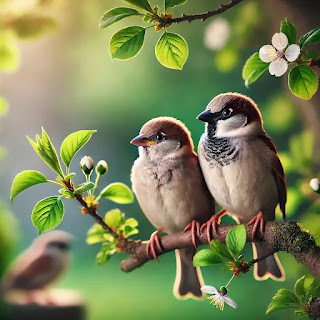World Sparrow Day: A Call to Protect Our Feathered Friends
Safiul Islam
M.A B.ED, History
Aliah University, Kolkata
Date: March 20, 2025
Introduction
Every year on March 20, nature lovers and environmentalists worldwide celebrate World Sparrow Day. This annual event aims to raise awareness about the dwindling population of sparrows and emphasize the need for concerted efforts to protect these small, chirping birds that were once an integral part of our surroundings. The day encourages people to reflect on the importance of sparrows in maintaining ecological balance and inspires action to preserve their natural habitats.
Origin and Significance
World Sparrow Day was first celebrated in 2010 as an initiative of the Nature Forever Society (NFS) of India, founded by Mohammed Dilawar, an Indian conservationist. Dilawar’s work in creating awareness about the declining sparrow population gained international attention, prompting the creation of a day to highlight the plight of these birds. The idea of dedicating a day to sparrows was further supported by the Eco-Sys Action Foundation (France), which works globally on biodiversity conservation.
The primary objective of World Sparrow Day is to bring attention to the alarming decline of sparrow populations due to rapid urbanization, habitat destruction, pollution, and modern agricultural practices. By observing this day, individuals, communities, and organizations are encouraged to take steps to create a safer environment for sparrows and other common birds.
Declining Sparrow Population: A Growing Concern
Sparrows, once ubiquitous in urban and rural landscapes, have witnessed a sharp decline over the past few decades. According to studies conducted by ornithologists and environmentalists, factors contributing to the dwindling population of sparrows include:
-
Loss of Habitat:Urbanization has led to the destruction of natural habitats, including gardens, hedges, and green spaces where sparrows traditionally nested. The replacement of traditional mud houses with concrete structures has eliminated the small crevices and cavities where sparrows used to build their nests.
-
Pollution and Radiation:Increased pollution, particularly air and noise pollution, has made urban environments inhospitable for sparrows. Moreover, the advent of mobile technology and the proliferation of cell towers have led to concerns about electromagnetic radiation affecting the navigation and communication abilities of birds, including sparrows.
-
Use of Pesticides and Chemical Fertilizers:The widespread use of pesticides and chemical fertilizers in agriculture has resulted in a drastic reduction in insect populations, which form the primary food source for sparrow chicks. Without adequate food, the survival rate of young sparrows has been negatively impacted.
-
Changing Food Habits and Garbage Disposal:The shift from traditional grain-based diets to processed foods and packaged products has reduced the availability of leftover grains that sparrows used to feed on. Additionally, improper garbage disposal practices have led to an increase in waste that attracts scavengers rather than small birds like sparrows.
Ecological Importance of Sparrows
Sparrows play a vital role in maintaining ecological balance. As insectivores, they help control the population of harmful insects and pests, thus contributing to the health of crops and plants. Furthermore, they serve as indicators of environmental health — a decline in their numbers often signals a deteriorating environment.
Efforts to Conserve Sparrows
Conservation efforts to protect sparrows have gained momentum over the years, with individuals, communities, and organizations taking proactive steps to reverse the decline. Some noteworthy initiatives include:
-
Creating Bird-Friendly Spaces: Urban planners and architects are now focusing on creating green spaces and incorporating nesting sites in modern infrastructure to encourage the return of sparrows.
-
Installation of Bird Feeders and Nesting Boxes: Environmentalists encourage households to install bird feeders and provide grains and clean water to attract sparrows. Nesting boxes can also be placed in gardens and balconies to offer safe spaces for sparrows to breed.
-
Educational Campaigns and Awareness Drives: Various NGOs and environmental groups organize workshops, seminars, and awareness campaigns to educate the public, especially children, about the importance of conserving sparrows and biodiversity.
-
Promoting Organic Farming: Advocating for organic farming practices helps reduce the use of harmful chemicals, thereby ensuring a safe food chain for birds and other wildlife.
How You Can Help
Protecting sparrows is not just the responsibility of conservationists but requires collective action. Here’s how you can contribute:
-
Install Bird Feeders: Place bird feeders in your garden, balcony, or terrace with grains such as millet, rice, and wheat.
-
Set Up Nesting Boxes: Encourage sparrows to nest by providing wooden or clay nesting boxes in open areas.
-
Avoid Chemical Pesticides: Opt for organic farming or gardening methods that minimize the use of harmful chemicals.
-
Plant Native Trees and Shrubs: Create a bird-friendly habitat by planting native plants that attract insects, providing a natural food source for sparrows.
-
Raise Awareness: Use social media platforms to spread awareness about the plight of sparrows and encourage your community to take action.
Conclusion
World Sparrow Day serves as a powerful reminder that even small creatures can have a profound impact on our ecosystem. As we observe this day on March 20, let us pledge to take conscious steps toward creating an environment where sparrows can thrive once again. With collective efforts, we can ensure that the cheerful chirping of sparrows continues to echo in our neighbourhoods, bringing joy and maintaining the delicate balance of nature.
References:
- Dilawar, Mohammed. Nature Forever Society: Protecting Sparrows and Biodiversity. NFS Publications, 2020.
- Ali, Salim. The Book of Indian Birds. Bombay Natural History Society, 1996.
- “World Sparrow Day.” Eco-Sys Action Foundation, 2023, www.ecosysaction.org.
- Ghosh, Sujata. “Impact of Urbanization on Sparrow Population.” Indian Journal of Ecology, vol. 45, no. 2, 2024, pp. 45–52.


Post a Comment